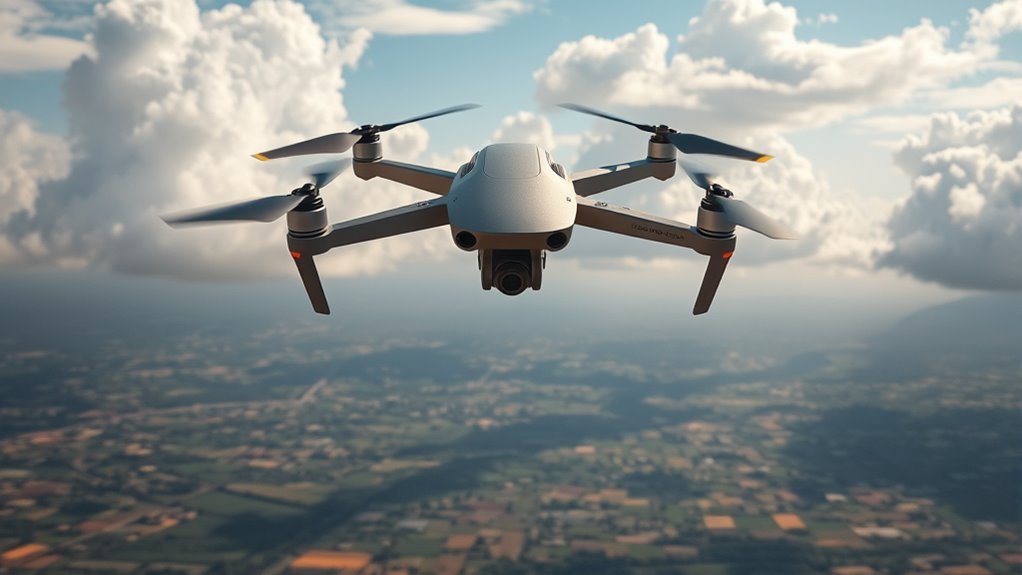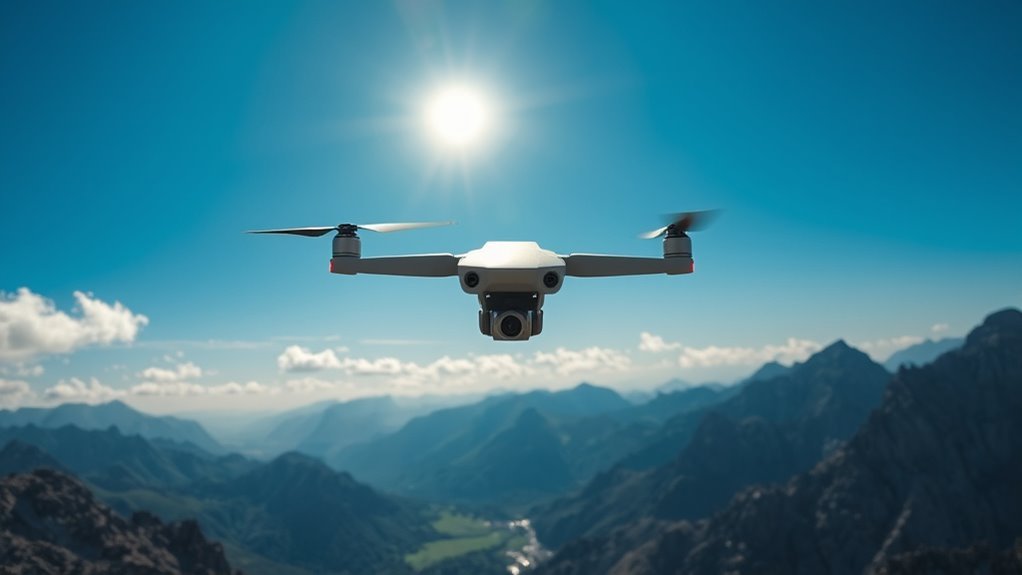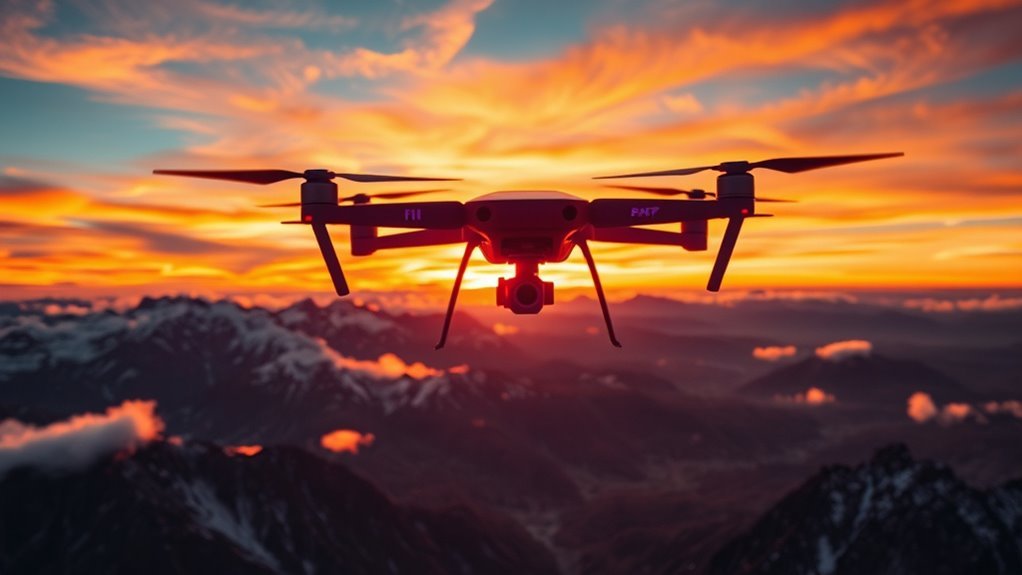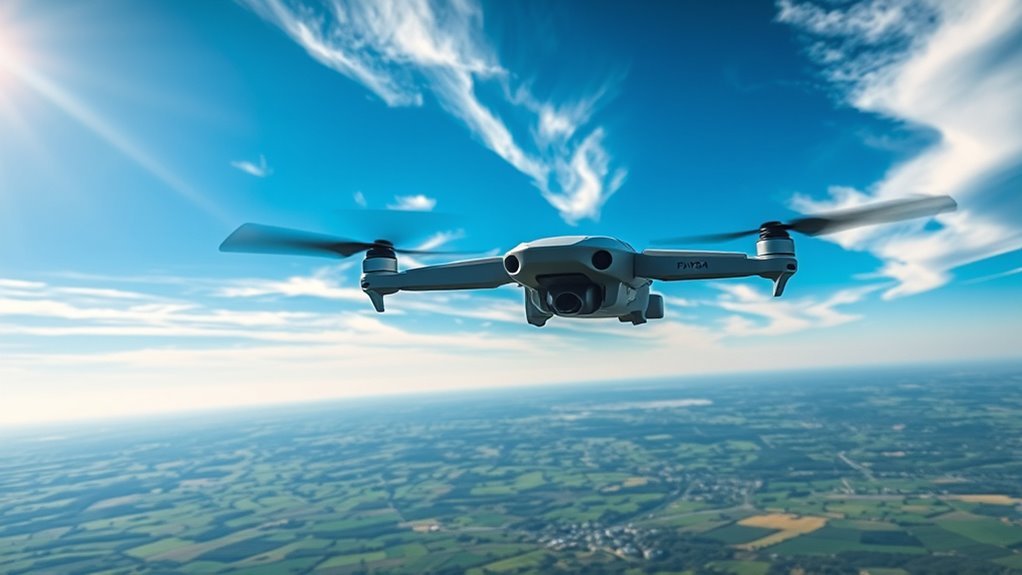High-altitude drones can reach impressive maximum altitudes, often exceeding 15,000 feet, with some capable of operating above 60,000 feet for specialized applications. Factors like drone design, battery capacity, and environmental conditions greatly influence their altitude capabilities. Military drones, for instance, can operate at altitudes between 15,000 and 70,000 feet, depending on their purpose. Understanding these specifications is essential for ideal performance and compliance. There’s much more to explore about this exciting technology and its future prospects.
Understanding Drone Altitude Limits

When you’re operating a drone, understanding altitude limits is crucial to confirm compliance with regulations and safety standards. Drone laws typically cap maximum altitude at 400 feet above ground level, unless you’re in controlled airspace with permission. This limit guarantees you’re not interfering with manned aircraft, thereby enhancing altitude safety. Staying within these parameters not only keeps you compliant but also preserves the freedom to operate your drone without legal repercussions. Additionally, being aware of signal attenuation can help you understand how altitude might impact your drone’s performance and connectivity. By monitoring your altitude using onboard GPS and altimeters, you can effectively manage your operational height. Always check local regulations, as they may impose stricter limits. Fundamentally, knowing these altitude limits empowers you to fly confidently and responsibly, safeguarding both your interests and public safety. Additionally, understanding battery life and power management can help you plan your flights more effectively to stay within safe altitude limits.
Factors Affecting Maximum Operating Altitude

While altitude limits are often set by regulations, several factors can influence a drone’s maximum operating altitude. One primary factor is altitude performance, which varies based on the drone’s design and intended use. High-performance drones typically feature advanced drone engineering, optimizing lift and propulsion systems for greater heights. Additionally, frequency bands utilized for communication can affect operational effectiveness at high altitudes. Environmental conditions, such as air density and temperature, also play an essential role; thinner air at high altitudes reduces lift, impacting stability and control. Additionally, battery capacity and payload affect maximum altitude, as heavier loads require more energy for ascent. Understanding these elements guarantees you can effectively assess your drone’s capabilities and maximize its potential while adhering to necessary regulations. Moreover, proactive vulnerability identification is crucial in ensuring the drone’s operational security as it ascends to higher altitudes.
Types of High-Altitude Drones

When considering high-altitude drones, you’ll encounter three primary categories: military, commercial, and research. Each type is engineered with specific capabilities and design features tailored to their operational requirements. Understanding these distinctions is essential for evaluating their performance at elevated altitudes.
Military High-Altitude Drones
As military operations increasingly rely on advanced technology, high-altitude drones have emerged as critical assets for surveillance and reconnaissance. These drones play a pivotal role in military applications, enhancing situational awareness and decision-making. Key features include:
- Extended Range: They can cover vast areas, providing extensive drone surveillance.
- High Altitude: Operating at altitudes above 60,000 feet, they evade most surface threats.
- Advanced Sensors: Equipped with cutting-edge imaging and electronic systems, they gather real-time intelligence.
- Stealth Capabilities: Many military drones utilize low-observable technology to minimize detection.
Incorporating these capabilities, high-altitude drones greatly improve operational effectiveness, ensuring that military forces maintain an edge in complex environments. Their versatility makes them indispensable in contemporary warfare.
Commercial High-Altitude Drones
Although high-altitude drones are often associated with military applications, the commercial sector has also seen significant advancements in this technology. Commercial drone applications now extend to fields like agriculture, environmental monitoring, and telecommunications, where altitude monitoring is essential. These drones can operate at altitudes exceeding 15,000 feet, allowing for expansive data collection over vast areas. For instance, in agriculture, they help assess crop health and optimize resource usage from above. In environmental studies, they monitor atmospheric conditions and track wildlife migration patterns. The ability to reach high altitudes grants you access to previously unreachable data, fostering greater insights and innovations. As the technology evolves, the potential for commercial high-altitude drones continues to expand, offering exciting opportunities for various industries.
Research High-Altitude Drones
High-altitude drones are categorized into various types, each designed for specific research applications and operational altitudes. Understanding these classifications enhances your ability to leverage their capabilities effectively in high altitude research. Here are four primary types:
- Stratospheric Drones: Operating above 60,000 feet, ideal for atmospheric studies.
- Tactical UAVs: Typically between 15,000 to 30,000 feet, suitable for military and environmental surveillance.
- Scientific Research Platforms: Designed for data collection in remote locations, often exceeding 30,000 feet.
- Persistent Surveillance Systems: They maintain altitude for extended periods, providing continuous data collection.
These high-altitude drones offer unique drone capabilities, enabling researchers to gather invaluable data while pushing the boundaries of exploration and observation.
Notable High-Flying Drones on the Market
Several notable high-flying drones currently dominate the market, each designed to reach impressive altitudes while maintaining stability and control. For instance, the DJI Matrice 300 RTK boasts a maximum altitude ceiling of 7,000 meters, making it a formidable choice for aerial surveys. In altitude comparisons, the Parrot Anafi USA offers a slightly lower max altitude but excels with its thermal imaging capabilities and rugged design. Another contender, the Skydio 2, emphasizes autonomous navigation, allowing you to capture high-altitude shots effortlessly. These drones come equipped with notable features like advanced GPS, high-resolution cameras, and obstacle avoidance, ensuring you can explore the skies with confidence and precision. Knowing your options helps you choose the best high-flying drone for your needs. Additionally, the Matrice 300 RTK’s battery life allows for extended flight times, enhancing its usability for longer missions. The Intel Shooting Star’s modular technology can also inspire similar innovations in aerial performance and design.
Military Drones and Their Altitude Capabilities
As military operations increasingly rely on aerial surveillance and reconnaissance, the altitude capabilities of drones have become a critical factor in their effectiveness. High-altitude military drones are designed for various applications, optimizing drone surveillance while minimizing risk. Here are four key altitude capabilities:
- Medium Altitude: Drones like the MQ-1 Predator operate between 15,000 and 25,000 feet, suitable for continuous surveillance.
- High Altitude: The U-2 can reach altitudes of 70,000 feet, enabling extensive reconnaissance missions.
- Very High Altitude: The Global Hawk operates up to 60,000 feet, providing real-time intelligence.
- Extreme Altitude: Some experimental drones can exceed 90,000 feet, pushing the boundaries of surveillance technology.
Understanding these capabilities is essential for effective military applications.
Commercial Drones: Performance and Regulations
When operating commercial drones, you must understand the regulatory altitude limits set by aviation authorities. These limits are influenced by the performance specifications of the drones themselves, as well as existing airspace restrictions. Maneuvering these factors is essential for compliant and efficient drone operations. Additionally, regulatory frameworks dictate specific altitude restrictions that must be adhered to in order to ensure safety and compliance during operations. It is crucial to remember that drones are prohibited to fly above 120 meters to mitigate risks and ensure public safety.
Regulatory Altitude Limits
Although regulatory altitude limits for commercial drones can vary considerably by jurisdiction, they are primarily designed to secure safe operations in shared airspace. To guarantee regulatory compliance, you should be aware of the following altitude restrictions:
- Maximum Flight Altitude: Generally capped at 400 feet above ground level.
- No-Fly Zones: Must steer clear of airports, military bases, and other sensitive areas.
- Vertical Limits: Some regions may impose additional vertical limitations.
- Special Permissions: Higher altitudes may require special waivers or authorizations.
Understanding these regulations is essential for maintaining safety while enjoying the freedom that drone technology offers. Stay informed on your local laws to guarantee you’re flying within legal parameters and optimizing your drone’s operational capabilities.
Drone Performance Specifications
Understanding drone performance specifications is essential for maximizing the operational efficiency of commercial drones, especially since these parameters directly impact your flight capabilities and compliance with regulations. Key drone specifications include maximum takeoff weight, battery life, and, importantly, altitude capabilities. The altitude at which your drone can operate safely is determined by its design and intended use. Higher-performing drones typically feature advanced propulsion systems and aerodynamic designs, allowing for greater altitude capabilities. However, it’s crucial to align these specifications with regulatory limits to avoid penalties and guarantee safety. Familiarizing yourself with these performance metrics will empower you to make informed decisions, optimize your drone’s efficiency, and ultimately enhance your freedom of operation in the skies.
Airspace Restrictions Explained
While traversing the complexities of drone operations, it’s essential to recognize that airspace restrictions play an important role in determining where and how high you can fly. Understanding airspace classifications and altitude zones is vital for your operational freedom. Here are four key points to take into account:
- Class G Airspace: Uncontrolled airspace, typically allowing higher altitudes without strict regulations.
- Class B, C, D Airspace: Controlled areas with specific altitude limits; you need clearance to operate here.
- Altitude Zones: Various zones dictate maximum flight ceilings that must be adhered to.
- Temporary Flight Restrictions (TFRs): May limit access due to special events or emergencies, impacting your flight plans.
Navigating these restrictions wisely guarantees compliance and safety while maximizing your drone’s potential.
The Role of Atmospheric Conditions
As atmospheric conditions fluctuate, they greatly influence a drone’s maximum operational altitude. Atmospheric pressure and temperature variations are critical factors. When pressure decreases at higher altitudes, drones may experience reduced lift, affecting their ability to maintain stable flight. Additionally, lower temperatures can impact battery performance and motor efficiency, leading to diminished operational capabilities. Motor power and efficiency are essential considerations for high-altitude performance, as they directly affect how a drone responds under varying conditions. You need to take into account these variables when planning high-altitude flights. For instance, a drone’s performance can vary considerably between a hot day at sea level and a cold, high-altitude environment. Understanding these dynamics empowers you to optimize flight paths and guarantee your drone operates effectively, maintaining the freedom you seek in the skies. Ultimately, adapting to atmospheric conditions will enhance your drone’s performance and extend its altitude capabilities. Furthermore, wind speed directly affects drone stability, which is crucial for high-altitude maneuvers.
Safety Considerations for High-Altitude Flights
When planning high-altitude drone flights, you must prioritize safety to mitigate risks associated with increased altitude. To guarantee ideal flight safety, consider the following:
- Understand altitude restrictions: Familiarize yourself with local regulations governing maximum allowable heights.
- Monitor weather conditions: High winds and turbulence can greatly impact drone stability and performance.
- Check equipment reliability: Regularly inspect your drone’s components, guaranteeing all systems are functioning properly to handle the demands of high-altitude flights.
- Establish a contingency plan: Prepare for potential malfunctions by having protocols in place for emergency landings or loss of control. Additionally, ensure you are aware of line of sight requirements to maintain safe operation during high-altitude flights.
Regulatory Framework Governing Drone Altitude
Understanding the regulatory framework governing drone altitude is essential for compliance and safe operation. These altitude regulations guarantee you fly within legal parameters, balancing innovation with safety. Knowing the limits helps you avoid penalties and enhances your freedom to operate.
| Regulation Type | Maximum Altitude | Compliance Required |
|---|---|---|
| FAA Part 107 | 400 feet | Yes |
| Recreational Use | 400 feet | Yes |
| Beyond Visual Line of Sight | Varies | Yes, with special waiver |
| Controlled Airspace | Varies | Yes, ATC authorization needed |
| No-Fly Zones | Varies | Yes, strict adherence |
Future Trends in High-Altitude Drone Technology
With the regulatory landscape firmly established, the focus is shifting toward the future of high-altitude drone technology. You’ll see significant advancements in several key areas:
- Autonomous navigation: Drones will increasingly utilize AI-driven systems for enhanced decision-making at high altitudes. User-centric autonomy will redefine how these systems operate in diverse environments.
- Advanced materials: Innovations in lightweight composites will improve structural integrity, allowing for higher operational ceilings.
- Energy efficiency: Next-gen propulsion systems will optimize fuel consumption, enabling longer flights without increasing altitude limits.
- Payload versatility: Enhanced designs will accommodate diverse equipment, from surveillance to environmental monitoring.
These trends will empower you to harness high-altitude drones with unprecedented capabilities, pushing the boundaries of what’s possible in aerial operations while ensuring compliance with evolving regulations. Furthermore, advancements in AI algorithms will enable real-time detection and evasion of obstacles at high altitudes, enhancing safety and navigation capabilities.
Frequently Asked Questions
What Is the Highest Recorded Altitude for a Drone Flight?
You’ll find that the highest recorded altitude for a drone flight showcases impressive drone records. Recent altitude achievements have reached over 30,000 feet, demonstrating the capabilities of advanced technology in pushing the limits of aerial exploration.
Can Drones Fly Above 60,000 Feet?
Ever dreamt of soaring like Icarus? While drone technology advances, flight regulations typically limit drones to much lower altitudes. Flying above 60,000 feet isn’t feasible for most drones due to legal constraints and technical challenges.
How Do Altitude Limits Vary by Country?
Altitude limits for drones vary considerably by country, influenced by local drone regulations and altitude enforcement practices. Understanding these differences can help you navigate the skies more freely while complying with each nation’s requirements.
What Are the Risks of High-Altitude Drone Flights?
Imagine soaring like an eagle; high-altitude drone flights face risks like regulatory challenges, airspace congestion, and safety threats. You’ve got to navigate these complexities to guarantee drone safety while maintaining your freedom in the skies.
Are There Altitude Restrictions for Hobbyist Drone Pilots?
Yes, as a hobbyist drone pilot, you’re subject to altitude compliance under hobbyist regulations. Most countries limit flights to 400 feet, ensuring safety and minimizing conflicts with manned aircraft, while still allowing enjoyable aerial experiences.

